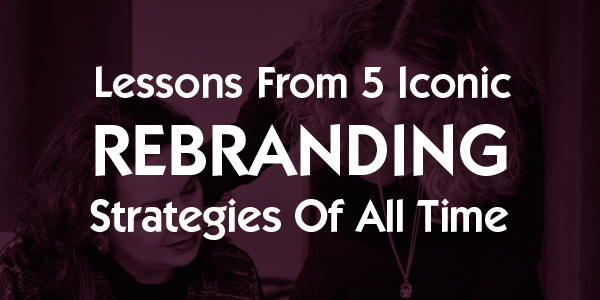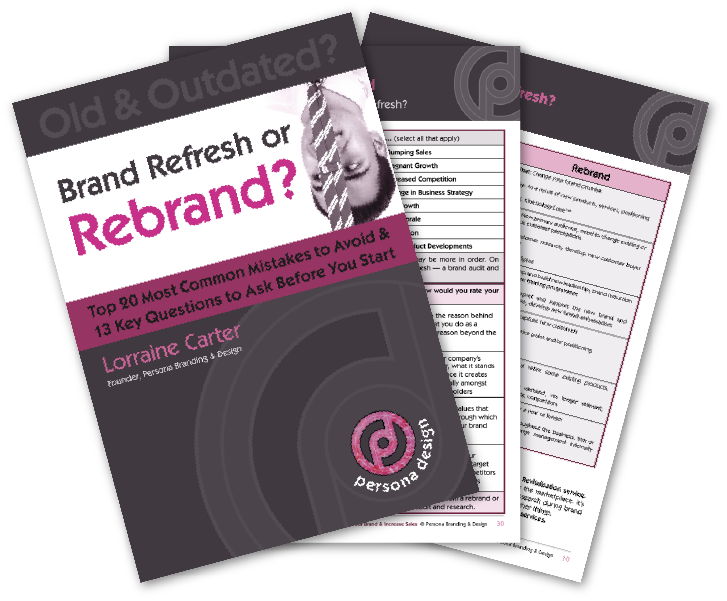
What You Can Learn from The Most Iconic Rebranding Strategies of All Time
A rebrand or brand refresh is never simply about changing logos and design aesthetics. Most successful rebrands are firmly driven by strong brand strategy, and often include a complete re-evaluation of business and marketing strategies, pricing, messaging, enhanced digital and physical presences, and of course, design.
In this article we’re taking a closer look at five successful and iconic rebrands with all one overriding commonality — they were all led by strong rebranding strategy. We’re sharing these insights with you so you can evaluate the key factors identified in the context of your rebrand, brand refresh or brand revitalisation to make more informed choices and achieve a better return on your investment.
There are countless graveyard stories of brands that have created a whole new look and feel for their brand without doing the essential due-diligence. They neglected to establish a rock-solid brand strategy to underpin those critical decisions resulting in either no business improvement or an accelerated loss in revenue or their complete demise.
This is not what we would call a ‘winning brand strategy’. In the following article, we’ve compiled some solid examples of how brand strategy should always lead rebrands. So without further ado, discover why these brands are our current shortlist of the Top 5 Most Iconic Rebrands of all Time! The lessons learned from each are invaluable to your brand success.

Get our complimentary ‘Rebranding and Brand Refresh Guide’ because it empowers you to unlock the exact systems and processes used to build standout brands with big brand know-how.
It contains key tools, checklists, references, tips and insights from over 20 years award-winning branding expertise to help lead you through the rebranding and brand refresh process successfully so you can increase your profits.
1. Apple’s Rebranding Strategy
Without question, Apple comes in at №1 on our Most Iconic Rebrands of All Time. Many might not realize this, but around 1997, Apple was nearing bankruptcy. They were suffering from poor sales, low consumer interest and a large market of competitors. The company did not stand out from their competition or really stand for anything at all.[1]
Then, Steve Jobs took over the company and completely revolutionized the way Apple, and the rest of the world thought about computers and technology. Under Jobs’ leadership, the Apple brand strategy was completely re-evaluated and overhauled.
Related: Profitable Lessons from Luxury Brand Leaders, Brand Positioning for Premium Pricing
With simplicity and innovation as core brand values, Apple captivated customers around the world. Steve Jobs headed up a new era of innovative products that were completely new to the market. These products, including iPods and iPhones, were key to Apple’s to success. The ease of use between all of their devices enabled them to morph into becoming a lifestyle brand, rather than just a brand for a much smaller niche professional audience, with a broad appeal that still underpins their success today.
If innovation was the meat and bun, then what was Apple’s extra special sauce? Simplicity. Apple was the first technology company to come in and simplify the user interface for people who were not ‘computer geeks’. The everyday folks. Apple sold its vision to the world of easy-to-use technology that makes your life easier — enhances your life — and in doing so, tapped into a universal emotional driver that still underpins its brand power today.
Related: Use Psychology in Your Brand Strategy to Create Irresistible Brand Experiences and Increase Sales

Image via ©Apple
With the user and ‘Apple experience’ in the forefront of every product they create, Apple brought themselves from the brink of bankruptcy to having more operating-capital than the US Treasury — and one of the most recognised brand names globally while also commanding a premium. Talk about a success story.
Related: How Apple Does It, Five Tips for Getting Your $1Tn Brand Personality Right
Lesson #1: Be crystal clear on your incomparable perceived added value and brand values. It would be impossible to miss Apple’s core values of innovation and simplicity. It is a part of everything they do, everything they say, the products that they produce, and their entire customer experience. What does your brand stand for? What are its core values? Do you and others refer to these core values for direction before making any decision, however big or small?
Apple’s Watershed Moment: 1984 Superbowl Advert
We know that sometimes it’s a struggle to build a brand strategy that really engages your ideal customers effectively so we’ve developed three different ways of working with us to help you build your brand, depending on your preferences, so if you’d like us to:
- Build your brand for you – find out more here or get in touch [email protected] or ring +353 1 8322724
- Empower you to build your brand – check out the Persona Brand Building Blueprint™ Mastermind here. This is a two-day intensive where you work on your brand with us codifying and mapping out your brand strategy for business growth. Alternatively, join our half-day Branding Accelerator Masterclass for a fast-injection of brand building essentials. Ask about our Personal and Corporate Leadership Brand Alignment Masterclass
- Want a DIY solution? check out our how to build a brand eprogramme here and our how to audit your brand yourself eprogramme here
2. Airbnb’s Rebranding Strategy
AirBnB is an online marketplace and hospitality service that’s become a pillar of the modern-day sharing economy. When Airbnb was first started by its two founders, it was called Airbed and Breakfast. The company had a much more casual feel, and the initial conceptual idea was that you would pay to stay on somebody’s air mattress in their home.
The company began to evolve and eventually needed to engage in a rebranding strategy because of outgrowth — a very common reason for rebranding in fast-growing new businesses. The company conducted an ‘in-depth immersion process’.
This process included four members of the rebranding team visiting 13 different cities so they could stay with 18 different Airbnb hosts. They immersed themselves in the Airbnb process, recording experiences as both a host and a guest. This process enabled the team to identify and distil what Airbnb actually meant to the two groups who use Airbnb the most; the guests and the hosts.[2] Through discussions and hands-on experiences, the meaning of Airbnb became crystal clear: ‘Belong[ing] Anywhere’
This new message became the guiding light to Airbnb’s entire rebranding strategy. Airbnb completely revamped their communications, website, logo, and brand voice to include this new message. Additionally, Airbnb introduced two new offerings with their enhanced brand strategy in mind: Airbnb Experiences and Airbnb Business.
Airbnb Experiences allows people to ‘host’ experiences in the city where they live. These experiences can range anywhere from $20-$500, and include all sorts of activities from city tours to cooking classes to DJ lessons to professional photography. Airbnb realized that in order to ‘Belong Anywhere’, you would need to be able to book more than just accommodation with them.
Their second offering was Airbnb Business. By listening to hosts and guests alike, Airbnb realized there was room to grow through offering business accommodation. This included making it easier for guests to find rental properties that were equipped for business trips and enabling companies to have their own Airbnb accounts. They realized that their philosophy and manifesto to ‘Belong Anywhere’ still applied, maybe even more so, to those travelling for business. Being away from family and friends can be lonely, so if you feel like you ‘Belong Anywhere’ through Airbnb, the business travel experience becomes psychologically a whole lot better.
The rebranding strategy and informed expansion of services has worked well for Airbnb. As of today, Airbnb has already booked over 1 million experiences and have boasted more than 260 million home and vacation rentals. They really are helping people ‘Belong Anywhere’ around the world.[3]

Image ©Airbnb via UnderConsideration
Lesson #2: Listen to your stakeholders. This does not only include your customers. In the case of Airbnb, they would have missed something BIG if they did not consult with and listen to their hosts. Who are the other stakeholders in your company? Have you discussed with them what your brand means to them? Have they helped you craft your brand strategy? If not, you might be missing something core to your growing success and profitability.
Related: Redefining Your Brand Culture After a Rebrand, Sale or Merger
3. Lego’ Rebranding Strategy
Danish toy-maker, Lego, has captured the imaginations and minds of kids (and parents) around the world. Even despite their recent collision (and competition) with the digital world (tablets and Youtube videos), playing with Legos is still a much-loved activity for many growing children.
However, this Danish company was not always so successful. The company faced bankruptcy back in 1990 and had to re-evaluate their business and what made them successful. Current chief executive, Jørgen Vig Knudstrop, realized that fundamentally the bricks were what made Lego successful. He loved the idea that kids could manifest and create their wildest imaginations out of homogenous plastic bricks. To him, Lego represented creativity and ingenuity. Because of this, Knudstop made the decision to ditch hundreds of other ancillary toy products in the Lego ecosystem, and refocus on their core strength, Lego’s bricks. Lego began rebuilding their company, brick by brick, and it worked! Just last year, Lego sold 62 billion Lego elements.
Today, Lego is capturing the younger generation with many digital offerings, including the wildly successful Lego movies. Always focused on their strong brand identity, Lego is moving forward in the digital era, sparking the imaginations and creativity of this new group of tech-native kids.
Related: A Rebranding Strategy Guide for Brand Owners and Managers
Lesson #3: Sometimes, a successful rebranding strategy can entail consolidating instead of adding more. In the case of Lego, the company realized they needed to change their brand strategy quickly. For them, the answer lay in eliminating non-core products that did not represent their core business or brand values and going all-in on the products that made them successful. Before you embark on a rebrand, it’s essential to engage in a brand audit so you can identify if your rebranding strategy needs to hone in on one specific product or demographic, or broaden its horizons.

Image ©Lego via Microsoft
Are you a business leader, manager or entrepreneur who wants to re-evaluate or build your brand strategy so you can effectively expand, leverage trends, new product developments or consolidate to increase your sales? Are you curious about how to build or scale a highly successful standout brand? Join one of our branding workshops because they empower you to build your brand, enhance customer experience, expand your market impact and create higher perceived value so you can command a premium.
In fact, the Persona Brand Building Blueprint™ Mastermind is all about fast-tracking you, your brand and your business through the brand building, brand strategy process using big-brand know-how with proven systems that get results so you can grow your business faster and more effectively.
If you want a tailor-made solution specifically for your brand then we also provide in-house bespoke Persona Brand Building Blueprint™ Intensives working with you and your team so you can grow your business faster and more profitably. Contact us to discover more [email protected] or +353 1 8322724
4. DropBox’s Rebranding Strategy
DropBox, a global file-hosting service, has always had a start-up feel. When they were first starting out, their platform had a very functional and brass tacks design and user experience. They relied on their superior product alone to garner market share.
Related: Rebranding: 15 Do’s and Don’ts for Brand Success
However, because they continued to grow successfully they eventually outgrew their original vision of just being a file-sharing service. Through a brand audit health check and market research, they realized that their platform was being used by companies and freelancers around the world to create, collaborate and share.[5]

Image via ©Dropbox
They were the go-to brand for creatives, professional photographers, marketing directors, and art aficionados alike. Their old-school, linear user-experience and product would need to be updated so that DropBox could step into their new role so their new brand strategy centred around ‘creative energy’ and helping people to do meaningful work (not just busy work). With their new rock-solid brand strategy, DropBox set out on one of the most dramatic rebrands in tech history.
Related: How to Build a Brand Like Amazon, Technology Branding and Marketing

Image via ©Dropbox
They launched a microsite that explained their entire rebrand, and also created quite a few digital and tv advert spots. The message was clear, DropBox is the premier file-sharing service for creatives and companies who want to be seen as creative. They completely updated their website which boasted new features and UX. Although it’s still too early to properly quantify the success of this particular rebrand, it makes our list because of its size, ambition and complexity.
Related: How to Use Brand Values to Drive Unwavering Customer Trust and Commitment
Lesson #4: Make sure your rebranding strategy is informed by how your products and services are used by your ideal customers. Leverage the insights and findings from a brand audit health check to establish how people (your core customers and stakeholders) see you? How do people use your products? If you really hone in on these two questions, you can create an effective and exciting rebranding strategy the revolves strongly around your customers.
5. Old Spice’s Rebranding Strategy
Perhaps the most viral rebrand that we have on this list is Old Spice and the infamous ad campaign that brought them from ‘old-fogey’ status to young and hip. The ad itself featured a former NFL player Isaiah Mustafa speaking to the women of the world, telling them ‘Look at your man, now back to me’.[6] This quirky advert appealed to younger audiences and instantly generated tens of millions of views online. That year alone, Old Spice saw an 11% spike in sales of their original body wash. The product hadn’t changed at all, but this fresh new revolutionary rebranding strategy enabled them repositioning the ‘old’ brand and so capture a whole new market of consumers.
Related: Boring Brand? How To Create a Unique Brand and Market Positioning
Nowadays, Old Spice totes one of the most diverse groups of users for male grooming products. What was once a brand primarily used by a shrinking 50+ crowd, Old Spice now has a predominantly younger clientele, with the largest age group being 34 and under.[7]
Related: Use Humour in Branding to Create Strong Emotional Bonds so You Increase Sales
Lesson #5: Firstly, honesty and a sense of humour can go a long way. Secondly, re-evaluation your ideal customer and targeting them relevantly with laser focussed strategic clarity is critical to your brand success. While most small businesses would have a hard time replicating the size and magnitude of Old Spice’s rebrand, it’s important to remember that lessons evidenced by larger companies are just as applicable to smaller ones.
Related: Increase Sales Using Buyer Personas, Your Guide to Understanding and Targeting Your Ideal Customers
No matter who your customers are or the size of your business, we can share four facts:
- Your customers like to laugh
- You need to know your ideal customers intimately — their needs, wants, love, hates and aspirations — if you want to build a brand that attracts their attention and retains their loyalty
- Your customers appreciate honesty, in fact, authenticity is a key cornerstone to any successful brand today, so make sure to keep yourself honest — or you’ll be found out!
- Don’t be afraid to think outside your ‘usual’ or ‘original’ target market because the market moves on, customers change, new competitors disrupt and you have to move fast in order to stay on top of trends and maintain relevance
If you’d like to discover more about building and maintaining a thriving, high performing, highly profitable standout brand, then get in touch because we’d love to help you make your brand into a profit powerhouse.
- Schedule an appointment — we can meet in person or online
- Allow us to create a customised plan for you
- Let’s implement the plan together
- Contact us [email protected] or ring +353 1 8322724 (GMT Dublin/London time 9:00 – 17:30 weekdays)
Lorraine Carter is a professional speaker and branding expert delivering talks that inspire and motivate along with masterclasses and workshops that inform and support transformational outcomes fast, and consultancy solutions that solve problems so you can outshine, outperform and leave your competitors way behind.
Final Word
Rebranding strategy is not a simple process. And, it is not something to be taken lightly or done simply because you think your business needs a “revamp”. In order to pull off a successful rebrand, you’ll need to dive deep into your company and target demographics by leveraging the insights and findings from a brand audit health check.
Every move, and we mean every single one, needs to be informed by data and customer feedback and always underpinned by your brand strategy.
Your brand strategy is the bedrock underpinning your entire business because it provides the direction for communications, marketing and design.
If you don’t have a rock-solid brand strategy before you begin your rebrand, you could land yourself in very uncomfortable choppy waters. Branding is NEVER marketing or design alone. Are you ready to deliver a winning rebrand for your company?
Related: Build Your Brand Strategy So It Drives Your Growth and Punches Above Your Weight
Questions to Consider
- What does your brand stand for? What are its core values?
- Who are the other stakeholders in your company? Have you consulted them about your current brand strategy?
- Are you trying to consolidate or broaden your brand strategy? What are the reasons underpinning your actions?
- How do people use your product or service? How do they view your company and brand(s)?
- How can you broaden your current target market?
- Is brand strategy underpinning your rebrand? How so?
Your Persona Client Satisfaction Guarantee
- When you work with us we’ll create a customised brand building plan and strategy with clear investment for you tailored to your specific requirements and preferences
- You’ll know each step of your brand building journey before we start because we’ll discuss it, document it and agree on it with you before work commences
- You’ll have timelines, key milestones and deliverables to evaluate and approve for each stage and part of your brand building process
- Because we know the unexpected sometimes happens we can make adjustments along the way if you need it and if something extra is requested we’ll ensure you’re fully appraised about what that entails before committing
- As we achieve pre-agreed objectives you’ll be able to evaluate your brand building work and strategy in progress, coupled with the outcomes to ensure return on investment
Get in touch today because we’d love to get started helping you build your standout, powerhouse brand so you can increase your profits and leave your competitors way behind.
Email us [email protected] or ring us +35318322724 (GMT 9:00-17:30) and ask about our VIP Brand Strategy Discovery.
References
- https://www.businessinsider.com/10-most-successful-rebranding-campaigns-2011-2#apple-was-nearly-bankrupt-now-its-ruling-the-world-9
- https://www.creativeboom.com/inspiration/20-of-the-best-rebrands-that-got-it-right/
- https://www.reuters.com/article/us-airbnb-growth/airbnbs-experiences-business-on-track-for-1-million-bookings-profitability-idUSKCN1FX2ZR
- https://www.theguardian.com/small-business-network/2015/jul/23/five-successful-rebrands-why-worked
- https://www.process.st/rebranding-strategy/
- https://www.theguardian.com/small-business-network/2015/jul/23/five-successful-rebrands-why-worked
- http://snapshot.numerator.com/brand/old_spice



